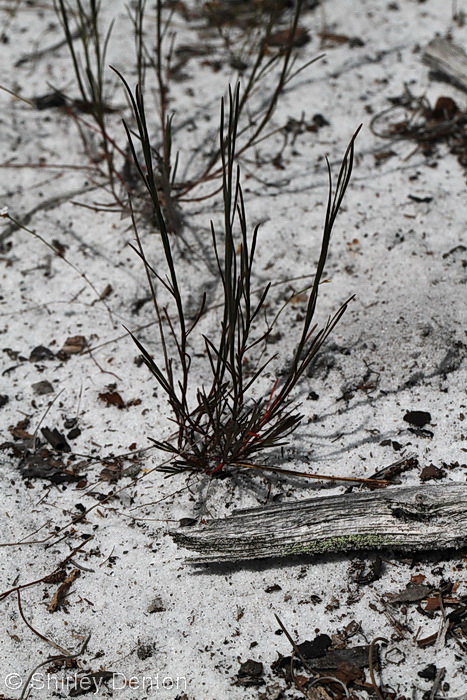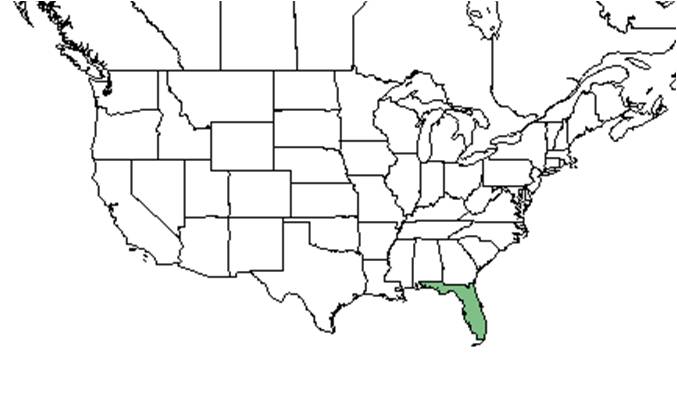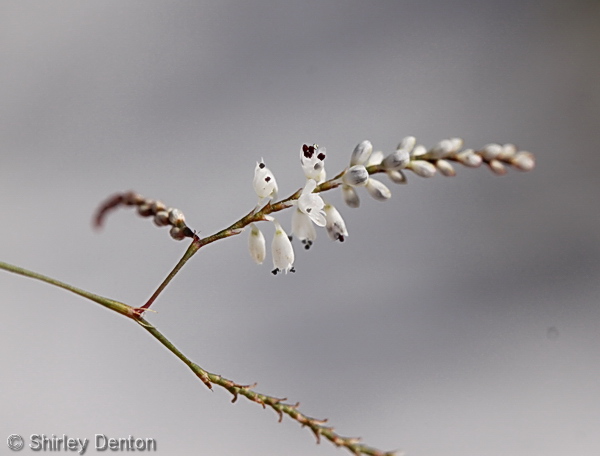Polygonella basiramia
| Polygonella basiramia | |
|---|---|

| |
| Photo by Shirley Denton (Copyrighted, use by photographer’s permission only), Nature Photography by Shirley Denton | |
| Scientific classification | |
| Kingdom: | Plantae |
| Division: | Magnoliophyta - Flowering plants |
| Class: | Magnoliopsida – Dicotyledons |
| Order: | Caryophyllales |
| Family: | Polygonaceae |
| Genus: | Polygonella |
| Species: | P. basiramia |
| Binomial name | |
| Polygonella basiramia (Small) G.L. Nesom & V.M. Bates | |

| |
| Natural range of Polygonella basiramia from USDA NRCS Plants Database. | |
Common names: Florida jointweed, Tufted wireweed
Contents
Taxonomic notes
Synonyms: Delopyrum basiramium Small; Polygonella ciliata Meisn. var. basiramia (Small) Horton
Description
A description of Polygonella basiramia is provided in The Flora of North America.
Distribution
It is endemic to the rosemary scrubs in Florida's Polk and Highlands counties.[1]
Ecology
Habitat
P. basiramia is limited to the xeric white and gray sands found along the Lake Wales, Winter Haven, and Bombing Range Ridges.[1] It it found primarily in gaps and disturbed roadsides of rosemary balds.[2] It is sensitive to the encroachment of shrubs and ground lichens due to increased competition for light or water (Hawkes and Menges 1995). Presence of other species has been found to negatively affect P. basiramia densities.
Associated species include Prunus geniculata, Sanidophyllum, and Paronychia pulvinata.[3]
Phenology
Flowers in November.[3][4] This is a gynodioecious species with perfect and pistillate flowers on different individuals. The perfect individuals have blue-black anthers.[2] It is a short-lived polycarpic perennial (Boyle et al. 2003).
Seed dispersal
The seeds are small and non-descript with no apparent adaptations for dispersal (Boyle et al. 2003).
Seed bank and germination
This species exhibits little seed dormancy and does not form a persistent seed bank.[2] It produces many seeds in one reproductive season, more than 30 times the established plant density (Hawkes and Menges 1995). In degraded scrubs germination is less limited compared to an intact scrub (Stephens et al. 2012). Leachates from Ceratiola ericoides has also been observed to reduce germination of P. basiramia (Hewitt and Menges 2008).
Fire ecology
P. basiramia is a gap-specialist found in both small and large gaps. It is sensitive to the encroachment of shrubs, accumulation of ground lichens and litter due to the increased competition for light and water (Boyle et al. 2003). There is a negative correllation between the presence of other species and P. basiramia density. As long as there are open gaps, it is able to persist without large-scale disturbances such as fire. It is potentially sensitive to fire due to short lived seeds and all individuals are killed (Hawkes and Menges 1995). Quintana-Ascencio and Menges (2000) suggest that patchy fires may benefit P. basiramia since it requires dispersal from unburned patches to establish in gaps rather than from a persistent seed bank.
Pollination
The following species were observed visiting flowers of Polygonella basiramia at the Archbold Biological Station:[5]
Plasterer bees from the family Colletidae: Colletes mandibularis
Sweat bees from the family Halictidae: Agapostemon splendens, Augochlorella gratiosa, Augochloropsis anonyma, Lasioglossum miniatulus, L. nymphalis
Leafcutting bees from the family Megachilidae: Megachile brevis pseudobrevis
Thread-waisted wasps from the family Sphecidae: Anacrabro ocellatus, Philanthus politus, Tachysphex similis
Wasps from the family Vespidae: Stenodynerus histrionalis rufustus
Conservation, cultivation, and restoration
Fewer than 150 populations remain along the Lake Wales, Winter Haven, and Bombing Range Ridges. Conversion of this land to urban and agricultural areas, along with fire suppression is threatening the ridges.[1]
US-Endangered
FL-Endangered
Cultural use
Photo Gallery
Flowers of Polygonella basiramia Photo by Shirley Denton (Copyrighted, use by photographer’s permission only), Nature Photography by Shirley Denton
References and notes
- ↑ 1.0 1.1 1.2 [[1]] Florida Natural Areas Inventory. Accessed: February 22, 2016
- ↑ 2.0 2.1 2.2 [[2]]Archbold Biological Station. Accessed: February 22, 2016
- ↑ 3.0 3.1 Florida State University Robert K. Godfrey Herbarium database. URL: http://herbarium.bio.fsu.edu. Last accessed: November 2015. Collectors: James D. Ray. States and Counties: Florida: Highlands. Compiled by Tall Timbers Research Station and Land Conservancy.
- ↑ Nelson, G. PanFlora: Plant data for the eastern United States with emphasis on the Southeastern Coastal Plains, Florida, and the Florida Panhandle. www.gilnelson.com/PanFlora/ Accessed: 19 MAY 2021
- ↑ Deyrup, M.A. and N.D. 2015. Database of observations of Hymenoptera visitations to flowers of plants on Archbold Biological Station, Florida, USA.
